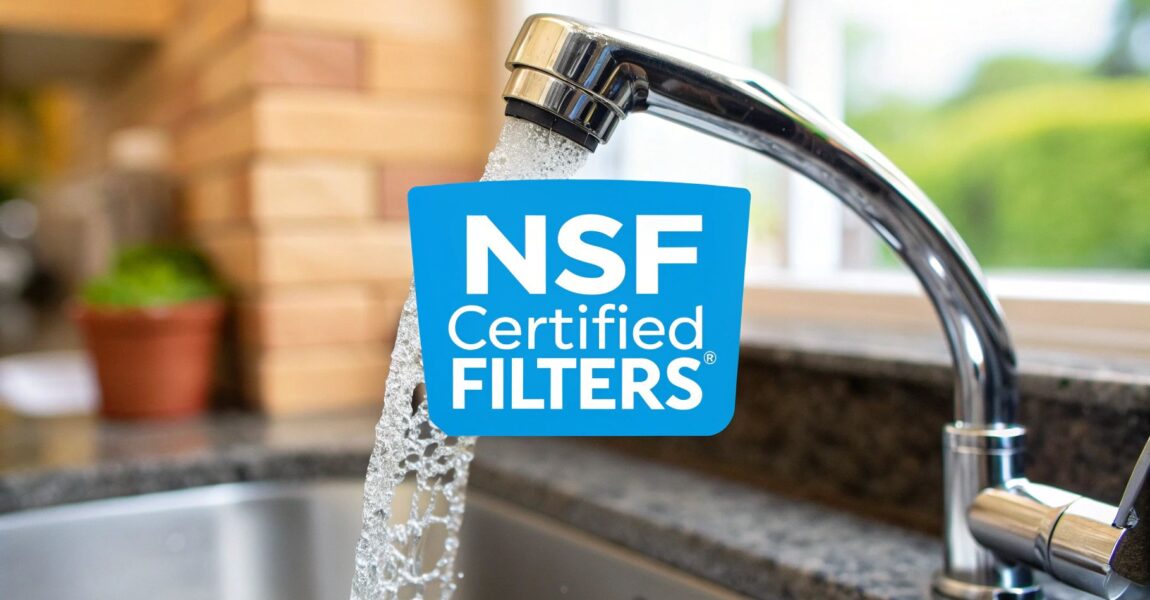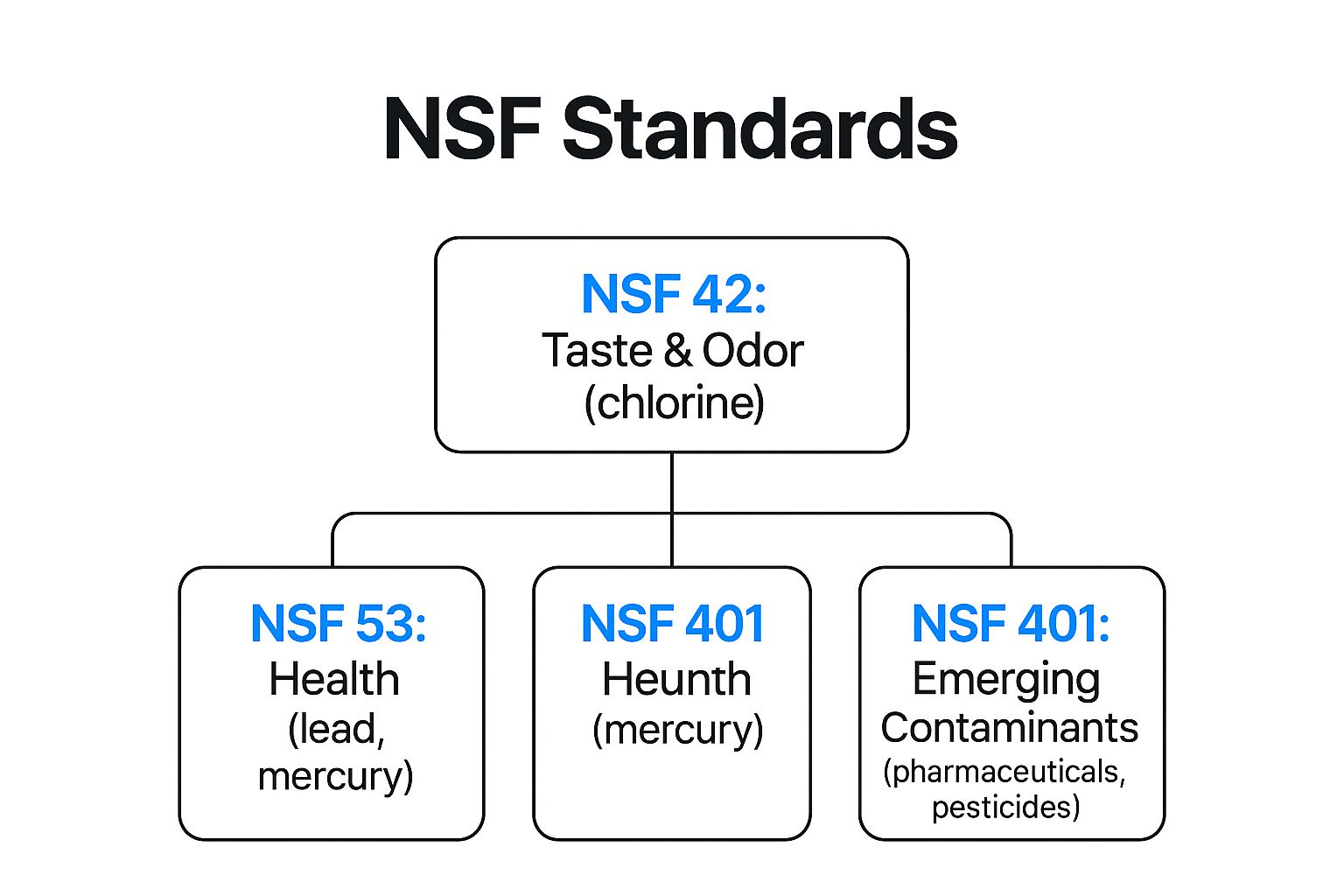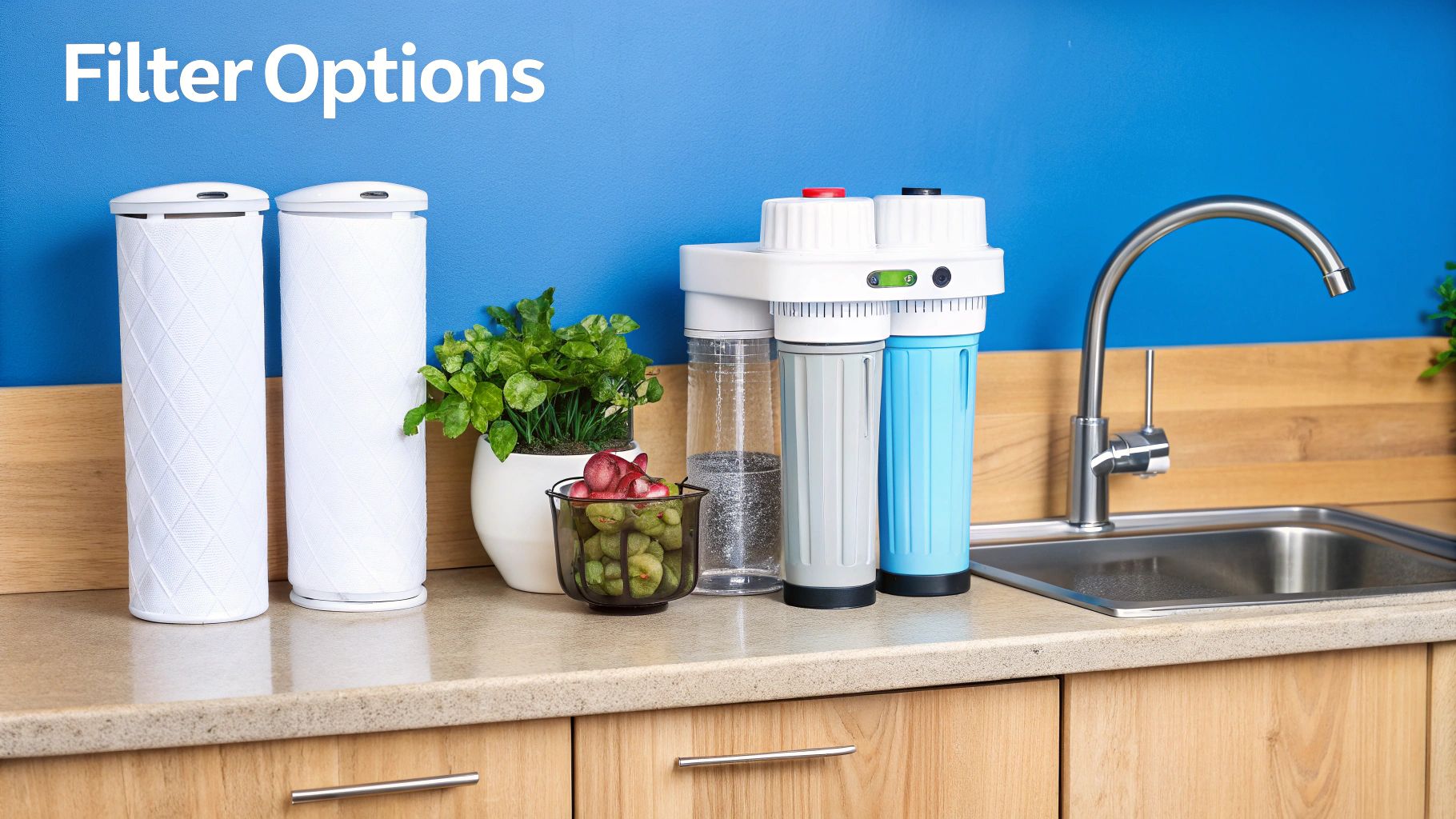
Ever stood in the water filter aisle, stared at a wall of boxes, and felt completely lost? You're not alone. When you're trying to find the best way to get clean, safe water for your family, seeing the letters "NSF" is like finding a lighthouse in a storm. Using an nsf certified water filters list is your secret weapon to ensure the water from your tap is as pure as it gets.
Think of NSF certification as a brutally honest, tell-all review from a world-class expert. It means the filter has been rigorously tested by an independent third party and proven to do exactly what the manufacturer promises. No marketing fluff, just verified results.
What NSF Certification Really Means for Your Drinking Water
Let's be real: when you buy a product to protect your family's health, you're putting a massive amount of trust in the company that made it. But without an unbiased referee checking their work, it's just their word against whatever gunk might be lurking in your pipes.
That's where the National Sanitation Foundation (NSF) steps in. They are the impartial judge, the trusted umpire for home water filtration. That little blue NSF seal isn't just a sticker; it's a rock-solid guarantee that the filter delivers on its promises of performance and safety.
To earn that seal, a filter has to survive a gauntlet of intense tests:
- Contaminant Takedown: The filter is challenged to prove it can actually remove the specific contaminants it claims to, whether that's lead, chlorine, pesticides, or microscopic cysts.
- Material Safety Check: Every single part that touches your water is meticulously analyzed to ensure it won't add any new, harmful chemicals back into the mix. No leaching allowed.
- Built to Last: The entire unit is pressure-tested to make sure it can handle the daily grind of your home's plumbing without springing a leak or falling apart.
This level of independent proof builds massive consumer confidence. It's no wonder that 92% of water filter owners say they have more trust in products certified by an organization like NSF. That confidence directly impacts how people shop—in fact, 81% of buyers feel much better about their purchase when they choose a certified filter. You can dig deeper into consumer trust in water filter certifications to see just how critical it is.
Beware the Marketing Mumbo-Jumbo
Keep an eye out for vague language. A company might claim its product "meets NSF standards" or is "NSF compliant." These phrases sound impressive, but they are not the same as being officially certified. It’s a marketing sleight of hand that often means the product has dodged the independent verification process entirely.
The NSF certification is a commitment to public health. It ensures the product in your home performs exactly as advertised, providing a reliable barrier against unwanted contaminants and giving you peace of mind with every glass.
Ultimately, choosing an NSF-certified filter removes the guesswork. It transforms a complex decision into a simple one based on verified science and trust. You're not just buying a filter; you're investing in a scientifically-proven tool to give your family safer, cleaner, and better-tasting water.
How to Decode the Secret Language of NSF Standards
https://www.youtube.com/embed/IP1qjUI24yM
Walking down the water filter aisle can feel like trying to decipher ancient hieroglyphics. You'll see numbers like NSF 42, 53, and 401 stamped on the boxes. What in the world do they mean for the water you drink every day?
Think of these numbers less like a random code and more like a specific job description for your filter. Each standard tells you exactly what that filter is certified to fight. Just because a filter is certified doesn't mean it removes everything, and learning to read these codes is the key to matching a filter to your home’s unique water quality challenges.
NSF 42: The Taste and Odor Specialist
First up is NSF/ANSI 42, which is all about the "aesthetic" qualities of your water. This is the standard that verifies a filter's ability to make your water taste and smell fantastic. Its primary job is to tackle non-health-related impurities that just make your water unpleasant to drink.
The most common villain it defeats is chlorine. While cities use it to disinfect water, it often leaves that distinct "public pool" smell and taste behind. An NSF 42 certified filter is your first line of defense, ensuring every glass is crisp, clean, and refreshing.
NSF 53: The Health Guardian
When your concerns go beyond just funky taste and odor, you need to look for NSF/ANSI 53. This is a much more serious standard focused on contaminants with known adverse health effects. Think of it as the bodyguard for your drinking water, trained to remove specific, harmful intruders.
This is the certification you need if you're worried about things like lead from old pipes, mercury, cysts like Giardia, or volatile organic compounds (VOCs). It's crucial to know that a product must be certified for each specific contaminant. Always read the fine print on the packaging to see exactly what an NSF 53 filter is certified to reduce.
A filter can be certified to NSF 53 for lead reduction but not for mercury. It's crucial to check the details to confirm it targets the specific contaminants in your local water supply.
To help you get a quick handle on these standards, here's a simple breakdown.
Common NSF Standards at a Glance
This table is your quick-reference cheat sheet for understanding what the key NSF certifications mean for your home water filter.
| NSF/ANSI Standard | What It Certifies | Common Contaminants Reduced |
|---|---|---|
| NSF/ANSI 42 | Aesthetic Effects | Chlorine, Taste, Odor, Particulates |
| NSF/ANSI 53 | Health Effects | Lead, Mercury, Cysts (Giardia), VOCs |
| NSF/ANSI 401 | Emerging Contaminants | Pharmaceuticals, Herbicides, Pesticides |
Bookmark this in your mind for your next trip to the store.
This infographic also helps visualize the primary roles of the most common NSF standards.

This guide shows how each standard addresses a different level of concern, from simple taste issues to serious health contaminants.
NSF 401: The Modern Contaminant Watcher
Finally, there's NSF/ANSI 401, one of the newer standards on the block. This one tackles what are called "incidental contaminants" or "emerging compounds." These are substances whose long-term health effects we're just beginning to understand.
We're talking about trace amounts of pharmaceuticals, over-the-counter medications, herbicides, and pesticides that find their way into our water supplies. While these are usually found in very small concentrations, many people prefer to remove them as a precaution. A filter with an NSF 401 certification offers an extra layer of defense against this modern category of contaminants.
By understanding these three key standards, you can confidently browse any NSF certified water filters list and choose a product that provides the exact type of protection your family needs.
Choosing the Right Type of NSF Filter for Your Home

Alright, you've cracked the code of NSF standards. Now for the fun part: picking the right tool for the job. The "best" water filter isn't just about what it removes—it’s about how it fits seamlessly into your life, your budget, and your home.
Think of it like buying a car. You wouldn't use a two-seater sports car to haul lumber, right? In the same way, a simple pitcher filter is perfect for a single person in an apartment, but it just won't cut it for a big family worried about what's coming out of every tap.
The global demand for clean water is exploding. The water filter market was valued at around USD 15.88 billion in 2024 and is expected to rocket to USD 26.42 billion by 2032. This isn't just a fad; it's a direct response to growing awareness about water quality and the amazing new filter technologies hitting the market.
Pitchers and Dispensers: Simple, Smart, and Effective
Water filter pitchers are the gateway to better water for most people, and for good reason. They’re affordable, require zero installation, and are perfect for renters or anyone who wants to keep things simple.
Just fill it up, pop it in the fridge, and you’ve got cold, filtered water ready to go. Most basic pitchers are certified to NSF 42, making them champions at improving taste and smell by eliminating chlorine. The best models also earn an NSF 53 certification for tackling nasty stuff like lead. Once your home water is sorted, finding the best water bottles for hiking is a great next step to stay hydrated on the go.
Faucet-Mounted Filters: Clean Water on Demand
Tired of the fill-and-wait game with a pitcher? A faucet filter is a fantastic upgrade. It attaches directly to your kitchen tap and delivers filtered water with the simple flip of a switch—no more waiting.
Installation is usually a snap and tool-free, making it another great choice for renters. These filters often carry both NSF 42 and NSF 53 certifications, offering a more powerful defense against common contaminants right where you fill your glass.
Your choice of filter should directly address your primary concern. If it's just about better-tasting coffee, a simple NSF 42 pitcher works. If your local water report shows lead, an NSF 53 certified system is non-negotiable.
Under-Sink Systems: The Hidden Powerhouse
If you're a homeowner looking for a more permanent and robust solution, an under-sink system is the champion. These systems are tucked away neatly under your cabinet, connect directly to the cold water line, and deliver purified water through their own dedicated faucet.
They boast a much higher filter capacity and a longer lifespan than pitchers or faucet mounts. Many are certified for NSF 42, NSF 53, and even NSF 401 to tackle emerging contaminants like pesticides and pharmaceuticals. Top-tier reverse osmosis (RO) models, certified under NSF 58, can remove an even broader spectrum of dissolved solids.
Whole-House Filters: The Ultimate Fortress of Filtration
For the most comprehensive solution, nothing beats a whole-house filter. Also known as a point-of-entry (POE) system, this unit is installed where the main water line enters your home. The result? It treats every single drop of water you use.
This is the ultimate choice for tackling widespread problems like hard water, sediment, or high chlorine levels that affect your showers, laundry, and appliances—not just your drinking glass. It's a bigger investment, for sure, but a whole-house unit provides total peace of mind by purifying all the water flowing into your home.
Our Top Picks for NSF Certified Water Filters
Trying to pick a water filter can feel like a guessing game. Every brand makes big promises, but how do you know which ones actually deliver? That's where we come in. We’ve cut through the noise and put together a straightforward list of our vetted NSF certified water filters to highlight options that are independently proven to do their job.
We've broken down our recommendations by type, making it easy to find the right match for your home, budget, and specific water concerns. You can rest easy knowing every filter here is backed by official NSF certifications, which means a trusted third party has put it through its paces.
Best Pitcher Filter for Simplicity and Performance
Brita Elite Pitcher Filter (Longlast+)
If you're renting, in a dorm, or just want an easy-to-use solution, the Brita Elite (you might know it as the Longlast+) is a fantastic choice. It’s the simplest way to get into water filtration—no tools, no installation, no fuss.
What makes this pitcher stand out is its certification lineup. It’s got the NSF/ANSI 42 certification, which means it dramatically improves the taste and smell of your water by tackling chlorine. But it also has the critical NSF/ANSI 53 certification for reducing nasty stuff like lead, mercury, and asbestos. That one-two punch makes it a surprisingly powerful filter for something so simple.
- Key Certifications: NSF/ANSI 42, 53
- Best For: Renters and anyone who needs a simple, affordable way to get lead and chlorine out of their drinking water without a complicated setup.
Best Faucet-Mounted Filter for On-Demand Convenience
PUR PLUS Faucet Filtration System
Tired of waiting for a pitcher to fill? A faucet-mounted filter gives you clean water right on tap, and the PUR PLUS system is a real winner in this category. It clicks right onto your kitchen sink for a seamless blend of convenience and serious filtration.
This thing is a workhorse, certified against NSF/ANSI 42, 53, and 401. So, it doesn't just make your water taste better (NSF 42) and pull out lead (NSF 53), it also handles emerging contaminants like certain pesticides and pharmaceuticals (NSF 401). A quick flip of a switch lets you go between filtered and unfiltered water, which is a great feature for making the filter last longer.
That triple certification is a big deal. It gives you a solid defense against a whole host of common water problems, making it one of the most capable faucet filters you can buy.
Best Under-Sink System for Hidden Power
Aquasana Claryum 3-Stage Under Sink Filter
For homeowners looking for a more permanent, high-capacity solution that doesn't clutter the countertop, an under-sink system is the way to go. The Aquasana Claryum 3-Stage system is an absolute beast that works its magic completely out of sight, feeding a dedicated, elegant faucet.
This filter is certified against NSF/ANSI 42, 53, and 401, and its multi-stage process is incredibly thorough. It’s proven to reduce over 77 different contaminants, including 99% of lead and asbestos, along with herbicides, pesticides, and pharmaceuticals. What’s really smart is that, unlike reverse osmosis systems, it leaves healthy minerals like calcium and magnesium in the water. You get all the good, none of the bad.
- Key Certifications: NSF/ANSI 42, 53, 401
- Best For: Homeowners who want a serious, long-term filtration system that tackles a massive range of contaminants while keeping healthy minerals in their water.
To make things even easier, here’s a quick side-by-side look at our top picks.
Top NSF Certified Water Filter Picks
| Filter Model | Type | Key NSF Certifications | Best For |
|---|---|---|---|
| Brita Elite (Longlast+) | Pitcher | NSF 42, 53 | Renters and simple lead/chlorine removal. |
| PUR PLUS Faucet System | Faucet-Mounted | NSF 42, 53, 401 | On-demand filtration for a wide range of contaminants. |
| Aquasana Claryum 3-Stage | Under-Sink | NSF 42, 53, 401 | Homeowners wanting comprehensive, hidden filtration. |
This should give you a solid starting point for finding the perfect NSF certified filter for your home and peace of mind.
How to Verify a Filter's NSF Certification Like a Pro
When it comes to your family's water, trust but verify. Anyone can slap a claim on a box, but how do you know it’s true? Learning to check for an official NSF certification yourself is the ultimate power move, giving you total confidence that a filter actually does what it says it will.
It’s a simple skill that cuts through marketing fluff and protects you from misleading claims. The best part? It only takes a minute.

The screenshot above shows the official NSF Certified Products Database—your one-stop shop for the truth about any filter's certification.
A Step-by-Step Guide to Verification
The only way to be 100% sure a filter is legitimate is to check the official NSF database. Be wary of vague phrases like “tested to NSF standards.” That’s not the same thing. Only an official listing in the database confirms the product survived the rigorous testing process.
Here’s how you can become a verification expert in four easy steps:
- Get the Product Info: Find the brand name and the specific model number. This is usually printed right on the box or in the online product description.
- Go to the Source: Head over to the official NSF Certified Drinking Water Treatment Units, Water Filters database. This is the only resource that matters.
- Search the Database: Type the brand or model number into the search bar.
- Check the Listing: If the filter is legit, it will appear in the search results. The listing will show you exactly which NSF standards it meets (like NSF 42, 53, or 401) and the complete list of specific contaminants it’s proven to reduce.
If a filter isn’t listed in this database, it is not NSF certified—no matter what the package says. This simple check is your best defense against clever marketing.
This process lets you see the full performance data sheet, so you can confirm every single claim the manufacturer makes. For more hands-on help choosing the right filter, you can find a ton of practical advice right here on our site. Learning more about water filter maintenance and selection will help you make a smart, informed choice. By verifying the certification yourself, you can be sure the filter you bring home is truly up to the job of protecting your family.
Common Questions About NSF Certified Filters
Even after you've waded through all the standards and product specs, a few questions always seem to pop up. Let's tackle those nagging doubts head-on so you can purchase your new filter with complete confidence.
The demand for certified filters is skyrocketing, and for good reason. In Europe, the water filter market hit USD 5.28 billion in 2024 and is expected to nearly double to USD 10.30 billion by 2033. This isn't just a trend; it's a direct response to growing concerns over water quality, with industrial and agricultural runoff linked to a staggering 3.5 million deaths worldwide each year from contaminated water. You can discover more insights on the European water filter market and see the data for yourself.
Is "NSF Compliant" the Same as "NSF Certified"?
Absolutely not. This is probably the single most important distinction to understand.
When a product is "NSF Certified," it means it has been sent to NSF International, put through a battery of independent tests, and proven to meet every single claim on its label. It’s a rock-solid guarantee that it does what it says it does.
On the other hand, phrases like "NSF compliant" or "tested to NSF standards" are just marketing speak. It usually means the company tested the filter themselves, in their own lab, without any third-party oversight. Always look for the official NSF seal on the product and double-check the model number on the NSF database.
Think of it like this: "NSF Certified" is like graduating with an official degree from an accredited university. "NSF Compliant" is like saying you "followed the curriculum" without ever taking the final exams or getting a diploma.
Do I Need a Filter if My Tap Water Is "Safe"?
Just because your city’s water meets the legal requirements doesn't mean it's as clean or tasty as it could be. For starters, municipal water is treated with chlorine. While it’s great for disinfection, it leaves behind a chemical taste and odor that most people find unpleasant. An NSF 42 certified filter is designed specifically to eliminate that.
More importantly, your water’s journey doesn’t end at the treatment plant. Contaminants like lead can easily leach into your water from old city service lines or even the plumbing inside your own home. An NSF 53 certified filter acts as the final line of defense, capturing these contaminants right at your tap before they ever make it into your glass.
At Water Filter Advisor, our mission is simple: to give you clear, honest information so you can find the perfect water filtration system for your home. Dive into our detailed guides and reviews to choose the right solution for your family.
Learn more and find your ideal filter at Water Filter Advisor
- October 10, 2025
- 0
- Uncategorized
